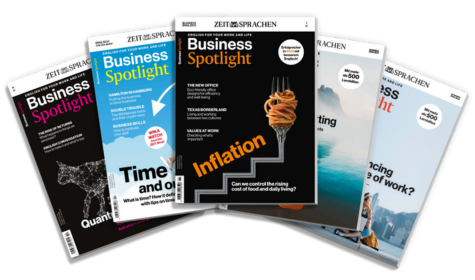From time to time, you probably get emails that are so confusing you have to read them several times before you begin to understand. It’s like being lost in a thick fogdichter Nebelthick fog. This sort of thing is a waste of time — emails fly back and forthhier: hin und her versendet werdenfly back and forth as you try to clear up the misunderstandings.
Here are ten email mistakes, or “fog factors”, and how to avoid them.
1. Too many topics in one mail
Email was designed as a short messaging systemNachrichtensystemmessaging system and should be used that way. This means it’s best to have only one topic per mail, so that the reader’s mind is focused. No email should be much longer than half a page. Otherwise, you should consider using another medium or sending an attachedbeigefügt, angehängtattached document.
2. An unclear subject line
Always add a clear and relevant subject lineBetreffszeilesubject line. This makes it easier to find the email later. Take care not to start a new topic under an old subject line. If the thread has grown so long that the topic has changed, email was probably not the right communication tool to use.
3. The key message is unclear
The key message should be at the beginning of each paragraph, in newspaper style. This makes your ideas easier to follow and remember.
4. An unclear layout
Leave some white spaceLeerraumwhite space on the page. A clear layout — with numbered paragraphs and bullet pointAufzählungs-, Stichpunktbullet points, for example — makes your emails much reader-friendlier.
5. Confusing pronouns
We use pronouns (“he”, “she”, “it”, etc.) to avoid repeating nouns, but always make sure that it’s clear who or what a pronoun refers to. This can be harder than it sounds. A team, for example, can be one thing (“it”) or a group (“they”): “My team is great. They work together really well.”
Plain English works best
6. Over-complicated vocabulary
Plain English works best. Write “start” not “commenceetw. beginnencommence”; “end” not “terminateetw. beendenterminate” and “send” instead of “dispatchetw. versendendispatch”, for example.
7. The sentences are too long
When writing, use more full stopPunktfull stops than commas. Vary the length of your sentences somewhat, but keep most of them short — a sentence with more than 20 words becomes difficult to read, especially if you’re writing to other second-language speakers. Sentences of 14 words or fewer are usually ideal.
8. The paragraphs are too long
Each paragraph should express one idea. Relevant background information and statistics can be included. Aim for a maximum of five or six sentences per paragraph.
9. Too many noun phrases
Use verbs rather thanstattrather than nouns to make a text shorter and easier to read:
- “apply forsich für etw. bewerbenapply for” is simpler than “make an applicationBewerbungapplication for”
- “reviewetw. überprüfenreview something” is better than “conductetw. durchführenconduct a review of something”
- “assessetw. beurteilenassess” is easier to understand than “make an assessmentBeurteilung, Einschätzungassessment of”
10. Old-fashioned language
Abstract language with old-fashioned phrases doesn’t grabetw. packen, hier: fesselngrab the reader’s attention. Write in a straightforwardeinfach, unkompliziertstraightforward way using the language of today:
- “because” not “due toaufgrund vondue to the fact that”
- “soon” not “in the near future”
- “if” not “in the event ofim Falle vonin the event of”
- “about” not “with reference toin Bezug aufwith reference to”
Here’s part of a fog-bounddurch Nebel behindert, hier: unübersichtlich, kompliziertfog-bound email:
With reference to your mail dated 15 April, please be good enough to advise sb.jmdn. benachrichtigenadvise us as tobezüglich, betreffendas to whether you will be in a position to dispatch the equipment as described at an earlier date if requested…
Now, let’s clear the fog:
Thank you for your mail dated 15 April. Please let us know how soon you can send the equipment once ordered…
Gustave Flaubert was asked the reason for his success as a writer. He wrote:
Whenever you can shorten a sentence, do.
And one always can.
The best sentence?
The shortest.
Follow Flaubert’s advice, and avoid the other nine fog factors. That way, your readers will know exactly where they are and where you want them to go.
ESSENTIAL PHRASES
Making the key message clear
- The reason I’m writing is to…
- The purposeZweckpurpose of this mail is to…
- I’d like to emphasize sth.etw. hervorheben, herausstellenemphasize the following...
- My key message is…
Keeping it short and simple
- Thank you for your mail dated 12 September.
- I’m writing about the May sales meeting.
- Please let us know your travel plans asap.
- Do you need any help booking hotels?
Using verbs rather than nouns
- I would like to apply for sth.sich für etw. bewerbenapply for the role.
- We need to review sth.etw. überprüfenreview our sales targets.
- Let’s assess sth.etw. beurteilen, einschätzenassess our staffing needsPersonalbedarfstaffing needs for next year.
- I’d like to evaluate sth.etw. beurteilenevaluate the effect of our ads on social media.
Using simple, modern language
- I can’t come to the meeting because I’m on holiday.
- I hope to see you again soon.
- We have a back-up plan if there is a train strike.
- I’m writing about your order.
Neugierig auf mehr?
Dann nutzen Sie die Möglichkeit und stellen Sie sich Ihr optimales Abo ganz nach Ihren Wünschen zusammen.



